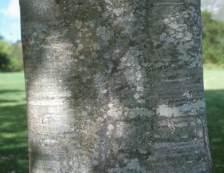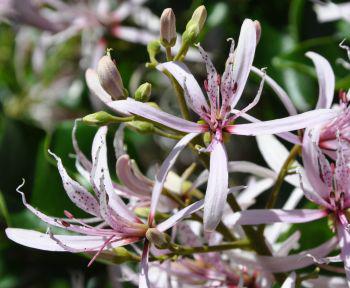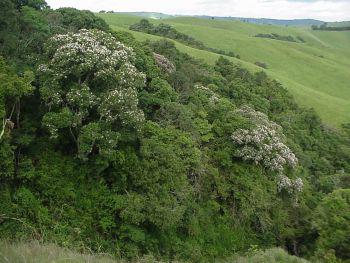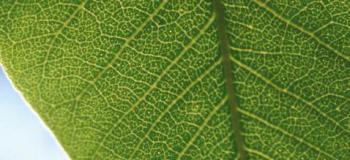Calodendrum capense
Calodendrum capense (L.f.) Thunb.
Family: Rutaceae
Common names: Cape chestnut, wild chestnut (Eng.); wildekastaiing, Kaapsekastaiing (Afr.); umbaba, umsitshana (Xhosa); umbhaba, umemezi omhlophe (Zulu), molalakgwedi, mookêlêla (N.Sotho); muvhaha (Venda)
Introduction
Calodendrum capense, a beautiful tree from the Cape, the name says it all: kalos means beautiful, and dendron is Greek for tree, capense is Latin for from the Cape. It is not only a tree of the Cape, but also a tree of Africa.

Description
Description
At the coast this tree is often evergreen, but inland it is deciduous with rich yellow autumn colours. In a forest environment, this tree can reach heights of up to 20 m, but at the forest margin or in the open it is shorter, approx. 7 m, with a more spreading canopy. In general this is a handsome well-shaped tree with a single trunk and a dense rounded canopy.

The trunk is smooth and an attractive mottled streaky grey, buttressed and lichen-covered in older specimens. The leaves are dark green, relatively large (5-22 cm long x 2-10 cm wide), simple, with untoothed undulate margins, and elliptic in shape.

When in bloom, the whole canopy turns pink. It is a magnificent sight. The flowers are large and striking, faintly sweet-scented and carried in conspicuous terminal panicles during early summer (October to December). Close up, each delicate flower has five long narrow pale pink petals (4-5 cm x 0.5 cm), alternating with five petal-like staminodes (sterile stamens), also pale pink but conspicuously dotted with purplish to maroon glands. The calyx is star-shaped and persists after the flower has dropped off.

The ovary, on a long gynophore (stalk carrying the female organs), swells to form the fruit which is green maturing to brown, 5-lobed woody capsule with a rough warty surface, splitting during late summer to autumn, to drop the large smooth black seeds which are hard but surprisingly light in weight.


Conservation Status
Status
According to the Red List of South African Plants, this species is assessed as Least Concern (LC).
Distribution and habitat
Distribution description
It occurs along the south and east coast of southern Africa from around Swellendam in the Western Cape through the Eastern Cape, KwaZulu-Natal, Mpumalanga, Swaziland, Gauteng, North West and Northern Province and into tropical Africa as far north as Tanzania and Ethiopia, and grows mainly in forests and kloofs (ravines / gorges), but occasionally in scrub and riverine bush, from sea-level to 2000 m.

Derivation of name and historical aspects
History
The genus name Calodendrum means 'beautiful tree', from the Greek kalos meaning 'beautiful', and dendron 'tree', capense is Latin for 'of or from the Cape'.
It got the common name 'wild chestnut' because William Burchell (1782-1863) thought that the flower and fruit resembled the horse chestnut. It is, however, not closely related to the horse chestnuts (Aesculus hippocastanum) in the Family Hippocastanaceae or the edible chestnuts, Castanea species, which belong in the Fagaceae, the beech & oak family. Carl Peter Thunberg (1743-1828), pupil of Linnaeus and the 'father of South African botany', was so excited at the sight of a tree in flower when he visited Grootvaderbosch in 1772, that he fired his gun at the branches until one broke and delivered the blooms into his hand. He was the one who named it Calodendrum.
Calodendrum capense is a member of the Rutaceae, the buchu & citrus family, a family of species that occur in warm temperate regions of the world, with 22 genera and 290 species in southern Africa.
One of the diagnostic features of this family is the presence of oil glands on the leaves, visible as tiny translucent dots when held up to the light. Another common feature, caused by the oil, is the strong scent of the leaves, particularly when they are crushed. Related tree genera in southern Africa include, Clausena, Vepris, Oricia, Citropsis, Zanthoxylum (=Fagara), Toddaliopsis, and Teclea. Well-known shrubby relatives include the buchus Agathosma species, and the confetti bushes Coleonema species.

Ecology
Ecology
The larvae of several butterfly species, including the orange dog (Papilio demodocus) which also uses other citrus family trees, breed on the foliage. Birds do not find the nectar-filled flowers inviting, but butterflies do feed on them. Samango and vervet monkeys, and rameron and olive pigeons, cinnamon doves and Cape parrots eat the seeds.
Uses
Use
The timber is white or light yellow, fairly hard but bends well and is easily worked. It is used for tent bows, wagon-making, yokes, planking, shovel handles, and furniture, and is considered one of the most generally useful hard woods.
The bark is used as an ingredient of skin ointments and is sold at traditional medicine markets.
Seeds are crushed and boiled to obtain oil that is suitable for making soap. The Xhosa believe that the seeds have magic properties, and hunters used to tie them around their wrists when hunting to bring them skill and good luck.
Growing Calodendrum capense
Grow
Calodendrum capense is a very ornamental tree, suitable for use as a shade or specimen tree in gardens and parks, also as a street tree. It does best in deep fertile, well-composted soil with plenty of moisture, particularly during spring and summer, and requires a warm sunny position. To develop and maintain its shapely canopy, it requires protection from strong, sustained winds, like Cape Town's south-easter. Young plants require protection from frost, but established specimens should be able to survive in Zone 9 (-7°C / 20°F) When grown in bitterly cold areas, it is likely not to flower very well.
Calodendrum capense is propagated by seed or cuttings. Seed can be sown as soon as it drops in late summer to autumn, or kept refrigerated and sown the following spring or summer. Sow in deep trays in well-drained soil. Germination should take 10-40 days but may be erratic with older seed. In colder climates, bottom heat should be used. This tree has a relatively long juvenile phase and will rarely flower until it is 7 or 8 years old.
Cuttings should be taken from new growth in spring to early summer, treated with a rooting hormone and rooted under mist using bottom heat. Trees propagated by cuttings should flower in 4 to 5 years. Young trees transplant easily and under ideal conditions can grow nearly 1 m in a year.
References
- Palmer, E. and Pitman, N., 1972, Trees of Southern Africa, A.A. Balkema, Cape Town
- Coates Palgrave, Keith, 1977, Trees of Southern Africa, First Edition, C. Struik Publishers, Cape Town, Johannesburg.
- Venter, Fanie & Julye-Ann, The Cape Chestnut, Farmers Weekly June 10, 1984.
- Leistner, O.A. (ed.), 2000, Seed plants of southern Africa: families and genera, Strelitzia 10., National Botanical Institute, Pretoria
Credits
Alice Notten
Kirstenbosch National Botanical Garden
December 2001
Plant Attributes:
Plant Type: Tree
SA Distribution: Eastern Cape, Gauteng, KwaZulu-Natal, Limpopo, Mpumalanga, North West, Western Cape
Soil type: Sandy, Clay, Loam
Flowering season: Early Summer
PH: Acid, Neutral
Flower colour: Pink
Aspect: Full Sun
Gardening skill: Average
Special Features:
Horticultural zones










Rate this article
Article well written and informative
Rate this plant
Is this an interesting plant?
Login to add your Comment
Back to topNot registered yet? Click here to register.